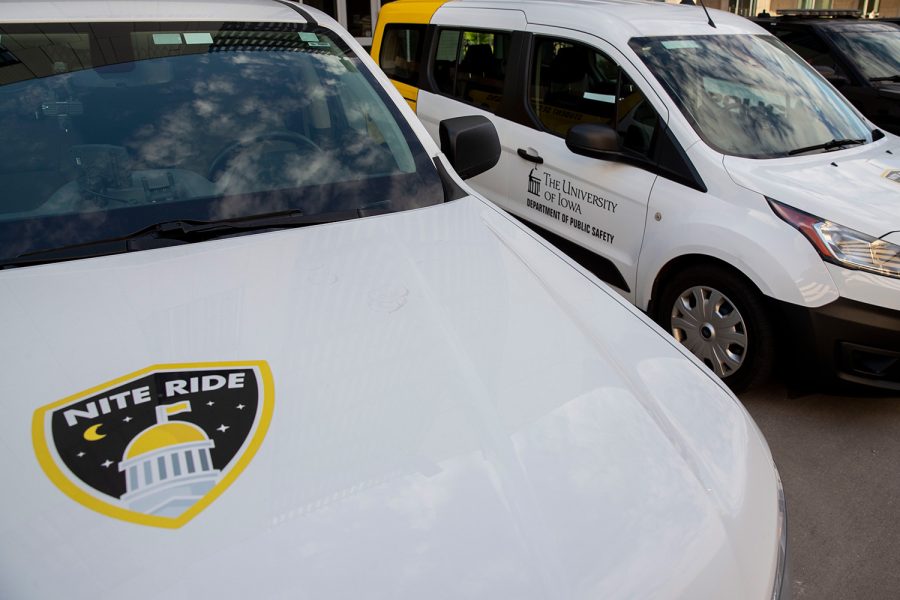Students express frustration with Nite Ride wait times, unreliability
Understaffing and other issues with the app have caused long wait times, some drivers said, and poor experiences some students have had with the service have caused them to lose faith in its reliability.
Nite Ride vehicles are seen in Iowa City on Tuesday, March 29, 2022.
March 29, 2022
University of Iowa students who use Nite Ride, a free late-night transportation service on campus, are feeling the impacts of the program’s understaffing.
The Nite Ride system runs daily from 10 p.m. to 5 a.m., which includes after the CAMBUS stops running at midnight. The high demand for rides and shortage of drivers, however, has made getting students home safely and in a timely manner difficult, first-year student and former Nite Ride driver Lauren Perry said.
Perry said when she worked in the fall 2021 semester, she wanted to ensure she picked everyone up safely when she had a long list of people.
Nite Ride runs on a first come, first serve basis. Students can pay a $1 fee to get an express ride if they need to be picked up faster, which automatically puts them above students who use the traditional service.
“We have two different systems,” Perry said. “We have your standard riders and we have the express line. So, honestly, I couldn’t see much difference with them, because a lot of the express drivers will also pick up regular people.”
There is usually a wait time for the rides, she said, but Nite Ride doesn’t show a live time estimate in case the wait time changes. On Nite Ride’s FAQ, the service suggests students request a ride up to half an hour ahead of time.
First-year student Unity Anderson, a current Nite Ride driver, said the program is understaffed like other businesses in the area and gets busy every night. The service remains a good option for students to get home safely, though, she said.
“People can rely on us to get us places safely,” Unity Anderson said.
Issues brought about by understaffing has made the service unreliable for some students like first-year Anali Anderson.
Anali Anderson said she has used Nite Ride twice and had bad experiences both times.
“If it came down to it, I would try to use Nite Ride again, but it wouldn’t be extremely helpful,” she said.
During On Iowa! week at the beginning of fall semester, Anali Anderson was using crutches to help her move around after a summer knee surgery. She called a Nite Ride to pick her up after attending Kickoff at Kinnick.
Anali Anderson said she stood on the street and watched as a Nite Ride vehicle drove past her.
She added that she gave them the benefit of the doubt and called Nite Ride for a friend a few weeks later, but when the Nite Ride arrived at her destination, there were too many people in the area, so the ride was canceled by the service.
RELATED: Iowa City Transit looks to implement cheaper bus fares
“Obviously it’s not something that is going to be a perfect system, I wish there was an app more like Uber in the sense that you can track exactly where the Nite Ride is and exactly where they need to pick you up,” she said.
Anali Anders said it would be a helpful addition if the service would send riders notifications, with consistent updates to show the longer wait. This way students’ time won’t be wasted when it doesn’t show up and an Uber must be called anyways, she said.
Beau Hartsock, security supervisor for the UI department of public safety, said during weekdays Nite Ride shuttles students from academic buildings home, but on weekends, Nite Ride mainly shuttles students downtown.
“We reach out specifically to students to help whenever we get concerns to potentially make our service better,” he said.
Hayley Bruce, assistant director for communication and external relations for the UI department of public safety, said Nite Ride takes feedback to improve upon the service over the years.
Anali Andersen said she hasn’t had the best experience with Nite Ride, but knows that it works really well for a lot of people.
“I know that everyone talks about Nite Ride, but it is important to make sure people understand what the service is supposed to be used for, and the service should be making sure students who need it are first in line over the students who don’t,” Anali Anderson said.



